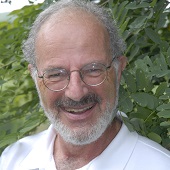France in August — Far from the Maddening Crowd
Is the French countryside tourist-friendly in the summer months?
September 11, 2009
Along the Loire, the Mayenne, the Sarthe, we retrace the steps of the Vikings, the Plantagenets and the Kings of France. Eleanor of Acquitaine lies buried at the abbey of Fontevraud, her sculpture reading a book, next to Henry II and Richard the Lionheart.
At Chateauneuf-sur-Sarthe is a statue to Jacques le Fort, who repelled the Vikings in the year 866. And then there is Catherine of Medici, who got rid of her spouse, Henri II of France, by smearing arsenic on pages which he licked and turned. Not to mention the ever-present Joan of Arc, complete with Voices.
Small towns and villages in Touraine, Anjou, Mayenne, are deserted. A set for post-apocalyptic movies? The Invasion of the Body Snatchers? No.
The radio reminds us that bodies are piled up and stacked on the beaches. On a scale reminiscent of the Great Invasions of the Dark Ages, the French move in two shifts to the beaches, bumper-to-bumper, on July 14 and August 1. They return a month later.
In Touraine, Anjou, Mayenne, we are the only car on whole stretches of minor highways cutting through lines of trees and open fields — up and down, passing by old houses, peaceful, hyper-passive cows savoring their European Union subsidies, horses and goats.
A distant slate church spire signals the next tiny town ahead. Some spires are twisted in order to help prayers rise better. Once the stronghold of armed Catholic resistance to the Republic which ended in genocide, today parishioners are few and the priesthood is slowly dying out.
First B&B.
Mme. B. dashes hither and thither like a stressed cricket to buy baguettes, smooth the gravel and look for maps — all while chattering nonstop. Now she is fussing about a few drops of orange juice spilt on the leg of a bed.
The small market town near Tours has morphed into an ugly bedroom community since the Train Grande Vitesse gets people to Paris, 160 miles away (257 km), in less than an hour’s train ride. Sablé, farther West, is 175 miles (281 km) from Paris and only an hour and a quarter by TGV.
Once even faster trains begin to run on the Lignes à Grande Vitesse now being built, even more of France’s towns and villages will turn into hideous, small boxes.
Pity the tourist trying to change currency in provincial France. Having forgotten our ATM cards at home, our attempts at changing dollar notes failed utterly. Having tried four banks in Sablé, we were sent to the post office, where an employee received us with bemused disbelief.
Calls to Laval, the closest larger town, did not help either. Currency is changed in bureaux de change, and if the nearest one is hours away, that is that. One American tourist trying to buy Euros was last seen wandering about Tours, a city of 140,000, in the general direction of the railroad station.
Knowledge of English is more widespread than it used to be, yet one open-air museum displays a sign stating, "Friendly visitors: you are free through the estate. Do not touch any displayed objects. No touching will prevent thieving tentatives".
Rather than widening roads and streets, the French have decided to turn them into obstacle courses. Dark green, grey, blue or white, two-feet tall bowling pins line small roads and streets, leaving barely enough width for a small car to squeeze by. At times, successive rows of pins shift from one side of the road to the other, adding to the excitement.
At dusk, they are almost invisible. While a drivers’ attention is distracted, concentrating on the tricky question of who has the right of way — or rather, whether the oncoming car entered the obstacle course first — one is apt to drive over robust (and equally invisible) speed bumps.
Second B&B.
Saint Denis d’Anjou. Tall ceilings, a gentle breeze, sunlight filtered through loose green jalousies, suffusing the large bedroom with the intimacy of a Matisse interior.
The smell of cows grazing nearby, burping once in a while. In the courtyard, a pond in which two ancient white ducks lead a quiet life, a hen with a scattering of one-day old chicks. Mme. L’s husband teaches how to drive horse-drawn carriages that are made in Poland, and have disk brakes.
Later, at Charles de Gaulle airport in the evening, we are hungry and looking for a restaurant. We try Terminal A, where everything is closed down. The entire staff must be on the beaches. Terminal B. Same story. At last we see people eating at the Hippopotamus in Terminal C.
The charming hostess tells us with a sweet smile that she won't be able to help us, as their computers are on the blink.
Takeaways
Pity the tourist trying to change currency in provincial France. Having forgotten our ATM cards at home, our attempts at changing dollar notes failed utterly.
Small towns and villages in Touraine, Anjou, Mayenne, are deserted. The French move in two shifts to the beaches, bumper-to-bumper, on July 14 and August 1 to return a month later.
Once the stronghold of armed Catholic resistance to the Republic which ended in genocide, today parishioners are few and the priesthood is slowly dying out.
Read previous
Lord Turner and the Tobin Tax
September 9, 2009
